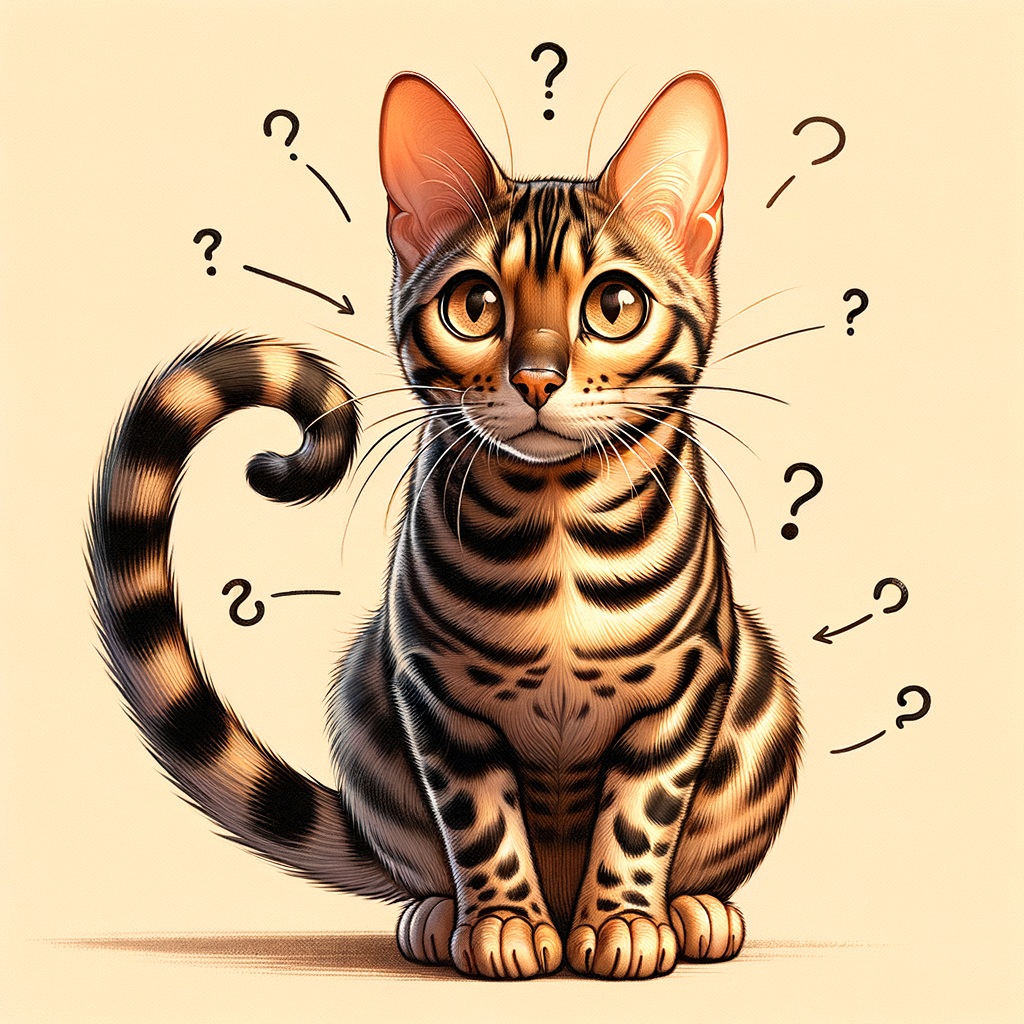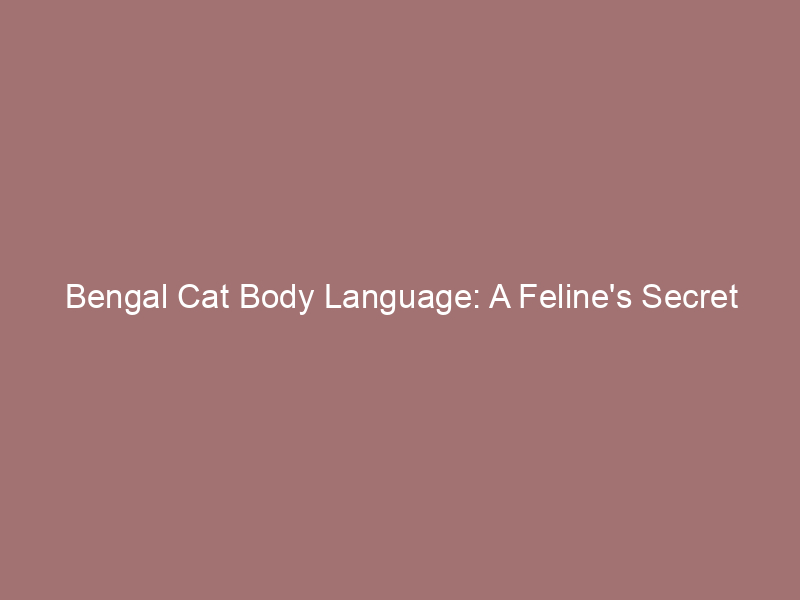
Introduction to Bengal Cat Behavior
- Overview of Bengal Cat BreedBengal cats are a unique and popular breed known for their wild appearance and playful nature. They are a cross between domestic cats and the Asian leopard cat. This gives them their distinctive spotted or marbled coat, which looks like a mini leopard.
Bengals are medium to large-sized cats. They have a muscular build and a sleek, shiny coat. Their eyes are usually green or gold, adding to their exotic look.
- Unique Characteristics of Bengal Cat BehaviorBengal cats are very active and love to play. They enjoy climbing, jumping, and exploring their surroundings. Because of their high energy levels, they need plenty of toys and activities to keep them entertained.
Another unique trait is their love for water. Unlike many other cats, Bengals often enjoy playing in water. You might find them splashing in a sink or even trying to join you in the shower!
Bengals are also very vocal. They communicate with a variety of sounds, including meows, chirps, and purrs. This makes them great companions, as they often “talk” to their owners.
Decoding Bengal Cat Communication
Bengal Cat Signals
- Interpreting Bengal cat actions
Bengal cats use their actions to communicate with you. For example, if your Bengal cat is rubbing against you, it means they are marking you with their scent. This is a sign of affection and trust. When they knead with their paws, it often means they are comfortable and happy.
Another common action is pouncing. This is usually a playful behavior, but it can also be a hunting instinct. If your Bengal cat is pouncing on toys or even your feet, they are likely trying to engage in play.
- Recognizing Bengal cat expressions
Bengal cats have expressive faces that can tell you a lot about how they feel. For instance, wide eyes and perked ears usually mean they are alert and curious. If their ears are flattened, this can indicate fear or aggression.
Pay attention to their whiskers too. Whiskers that are pushed forward can mean they are interested or excited. Whiskers that are pulled back might indicate they are scared or annoyed.
| Action | Meaning |
|---|---|
| Rubbing against you | Showing affection and marking scent |
| Kneading with paws | Feeling comfortable and happy |
| Pouncing | Playful behavior or hunting instinct |
| Wide eyes and perked ears | Alert and curious |
| Flattened ears | Fear or aggression |
| Forward whiskers | Interest or excitement |
| Backward whiskers | Scared or annoyed |
Identifying Bengal Cat Moods
-
Reading Bengal Cat Gestures
Bengal cats use their bodies to communicate. By watching their gestures, you can understand their moods. For example, a Bengal cat with an arched back and puffed-up fur is likely scared or threatened. On the other hand, a cat that is stretching out and showing its belly is probably relaxed and happy.
Here is a table to help you identify some common gestures:
Gesture Meaning Arched back Fear or aggression Showing belly Relaxation and trust Slow blinking Affection Tail flicking Annoyance -
Interpreting Bengal Cat Vocalizations
Bengal cats are very vocal. They use different sounds to express their feelings. A common sound is the “meow.” A short, soft meow often means your cat is greeting you. A loud, long meow might mean they are hungry or need attention.
Here are some common Bengal cat sounds and their meanings:
- Purring: Contentment and happiness.
- Hissing: Fear or anger.
- Chirping: Excitement, often when watching birds.
- Growling: Warning or feeling threatened.
Bengal Cat Tail Movements
- Meaning of Different Tail Movements
Bengal cats use their tails to communicate. The position and movement of their tails can tell you a lot about how they feel. Here are some common tail movements and what they mean:
-
-
- High Tail: When a Bengal cat holds its tail high, it usually means the cat is happy and confident.
- Low Tail: A low tail can indicate that the cat is feeling scared or anxious.
- Puffed Tail: If the tail is puffed up, the cat might be frightened or trying to appear larger to a threat.
- Swishing Tail: A tail that swishes back and forth quickly can mean the cat is annoyed or agitated.
-
- Examples of Tail Movements and Their Interpretations
| Tail Movement | Interpretation |
|---|---|
| High Tail | The cat is feeling happy and confident. It might be ready to play or explore. |
| Low Tail | The cat is feeling scared or unsure. It might be hiding or trying to avoid something. |
| Puffed Tail | The cat is frightened. It might be trying to make itself look bigger to scare off a threat. |
| Swishing Tail | The cat is annoyed or agitated. It might be warning you to stay away. |
Deciphering Bengal Cat Eye Contact
Interpreting Eye Contact Signals
- The meaning of prolonged eye contact: When a Bengal cat holds eye contact with you for a long time, it can mean several things. Often, it shows trust and comfort. Your cat feels safe and secure around you. However, in some cases, prolonged eye contact can be a sign of dominance or a challenge.
- Decoding the meaning of avoiding eye contact: If your Bengal cat avoids eye contact, it might be feeling scared or anxious. This behavior can also indicate submission. Cats often avoid eye contact with other cats or people they see as more dominant. If your cat is avoiding eye contact, try to make it feel more comfortable and safe.
Case Studies: Bengal Cat Behavior in Different Scenarios
Case Study 1: Bengal Cat in a New Environment
- Observations of Bengal cat behavior
When a Bengal cat enters a new environment, it often explores every corner. It may sniff around, rub its face on furniture, and even climb to high places. This behavior helps the cat get familiar with its new surroundings.
In some cases, the Bengal cat might hide under furniture or in small spaces. This is a normal reaction as the cat adjusts to the new environment.
- Interpretation of Bengal cat signals
If the cat’s tail is upright and it is purring, it feels comfortable. However, if the tail is low or puffed up, the cat might be scared or anxious.
Wide-open eyes can indicate curiosity, while narrowed eyes might show that the cat is feeling threatened.
Case Study 2: Bengal Cat Interacting with Other Pets
- Observations of Bengal cat communication
When Bengal cats interact with other pets, their communication is unique. They use a mix of vocal sounds, body language, and facial expressions. For instance, a Bengal cat might chirp or meow to get attention from a dog or another cat. They also use their tails and ears to show how they feel.
- Bengal cat moods in a multi-pet household
In a home with multiple pets, Bengal cats can show different moods. They might be playful, curious, or sometimes even a bit shy. Notice these moods to keep harmony in your home. For example, if a Bengal cat’s tail is puffed up, it might be scared or excited. If it’s wagging slowly, the cat might be curious or relaxed.
| Behavior | Meaning |
|---|---|
| Chirping | Wants attention or is excited |
| Puffed-up tail | Feeling scared or excited |
| Slow tail wagging | Curious or relaxed |
Key Takeaways: Your Bengal Cat Better
- Bengal cat body language:
It helps you know when they are happy, scared, or angry. For example, a swishing tail can mean they are annoyed, while a slow blink shows they trust you.
- How to improve your relationship with your Bengal cat through better communication:
Better communication with your Bengal cat can strengthen your bond. Spend time observing their behaviors and responding appropriately. Playing with them regularly and respecting their space when they need it can make your relationship stronger and more enjoyable.
| Behavior | Meaning |
|---|---|
| Swishing Tail | Annoyed or Agitated |
| Slow Blink | Trust and Affection |
| Meowing | Needs Attention or Food |
| Arched Back | Fear or Aggression |






